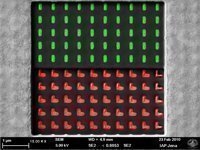
Chiral loop wire metamaterial with giant optical activity.
Picture: IAP (University Jena)On a microscopic level, natural solids consists of an atomic structure. When visible light passes through such media, the wavelength of light is hundreds of times larger than the atoms. Hence the atomic details are not resolved and lose importance in describing how the lattice interacts with light. In an analogous manner, metamaterials are obtained by assembling nanosized, i.e. sub-wavelength artificial atoms, which can be achieved by high-standard nanotechnology. In our group, such dedicated state-of-the-art technology facilities centered around electron- and ion-beam lithography as well as a multitude of nanopattern transfer techniques are readily available in close collaboration with the Microstructure Technology group within our institute and the Fraunhofer Institute of Applied Optics and Precision Engineering. This key technology is the main enabler for the realization of artificial matter with unprecedented optical properties.
Double layer metamaterial for asymmetric transmission of linearly polarized light.
Picture: IAP (University Jena)Our group puts a major effort in the modeling, design, and characterization of artificial metamaterials, both in the linear as well in the nonlinear regime. We are interested in the enhancement of naturally occurring optical effects as well as the exploration of novel optical response functions that are not amenable by naturally occurring media. Main research directions are new designs of metamaterials for properties like negative refraction, electromagnetic field concentration, chirality, asymmetric transmission, as well as their respective experimental realization. Tightly bonded collaborations with the Theoretical Optics group at our university (www.photonik.uni-jena.deExternal link) provide us furthermore the possibility to implement various theoretical concepts into practical devices. We are moreover specialized in an accurate optical characterization of our fabricated nanomaterials, comprising their amplitude- and phase-resolved optical far-field responses as well as their electromagnetic near-fields under excitation conditions.

